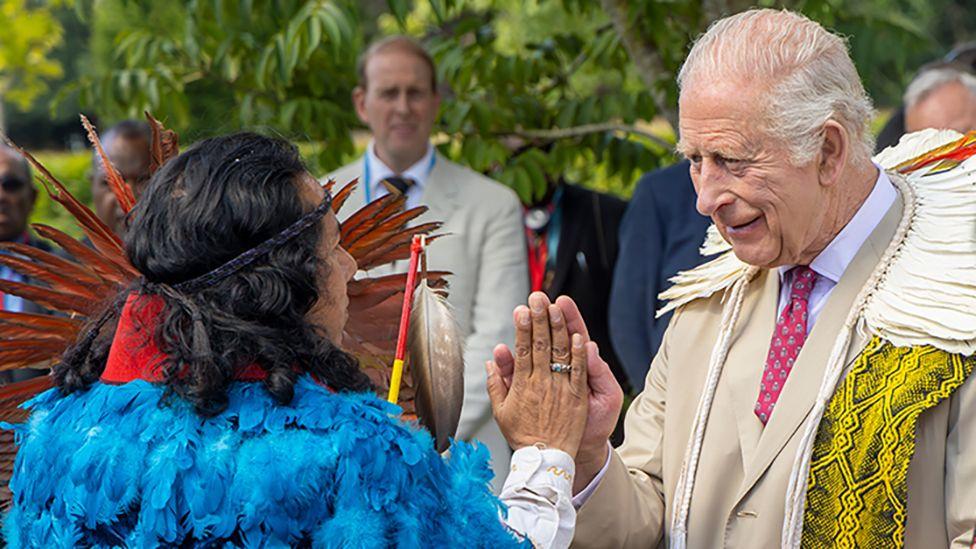A Unique Royal Gathering at the Harmony Summit
The Highgrove estate, nestled in the heart of Gloucestershire, was the setting for a special event that stood apart from traditional royal occasions. It was here, amidst the sun-drenched gardens, that King Charles hosted his first “Harmony Summit,” an initiative aimed at fostering a deeper connection between humanity and nature. The gathering brought together a diverse group of individuals, including Indigenous leaders, environmentalists, farmers, educators, and artists, all united by a shared vision of harmony with the natural world.
The summit kicked off with a symbolic fire ceremony led by an Indigenous Earth Elder, who wore a striking headdress and a robe adorned with blue feathers. As the fire burned within a circle of flowers, participants raised their arms in reverence to nature, rotating to honor the cardinal directions and Mother Earth. A conch shell was blown, and butterflies fluttered around the blooming flora. In a nod to modernity, the elder read his incantations from an iPhone, blending tradition with contemporary technology.
Among the attendees were representatives from various Indigenous tribes, including those from the Amazon region, as well as climate activists, organic farmers, herbalists, and philanthropists. Notably, actor Rainn Wilson, known for his role in The Office, joined as a director of a climate change group, while a film crew from Amazon Prime documented the event for a future documentary. The King, dressed in a light summer suit and adorned with a feather circlet and a ceremonial scarf, welcomed guests with quiet dignity.
The Philosophy of Harmony
For King Charles, the concept of harmony is more than just a philosophical ideal—it is a guiding principle that underpins his many endeavors. In his 2010 book Harmony: A New Way of Looking at Our World, he explores the interconnectedness of all life, emphasizing the spiritual bond between humans and nature. He describes nature as “her,” highlighting the need to work with the grain of the natural world rather than against it. This philosophy extends to his efforts in environmental conservation, sustainable farming, urban planning, and the preservation of traditional crafts.
According to a source close to the King, this idea of harmony is central to his legacy, bringing together disparate aspects of his work into a cohesive worldview. Once considered an outlier, his environmental and spiritual beliefs are now increasingly recognized as mainstream thought. His book serves as a call to revolution, challenging consumer culture and advocating for a return to sustainable practices.
Spiritual Foundations and Interfaith Dialogue
King Charles’s commitment to harmony is deeply rooted in his personal faith. At the Harmony Summit, grace was said by the Bishop of Norwich, Graham Usher, who noted the King’s deep Christian spirituality. The Bishop described how the King draws strength from prayer and contemplation, seeing his role as one of service. He also emphasized the King’s interest in interfaith dialogue, particularly with the Orthodox Church and its use of icons.
Highgrove itself reflects this spiritual dimension, with a private sanctuary where the King can retreat for solitude and reflection. This sense of sacredness extends beyond religion, encompassing a reverence for nature and the interconnected web of life.
Voices from the Indigenous Community
The summit provided a platform for Indigenous leaders to share their perspectives on the challenges they face. Ray Mears, a survivalist, welcomed representatives of the Earth Elders, who advocate for the rights of original peoples. These leaders spoke about the destructive pressures of mining, oil extraction, and urbanization, which threaten their way of life.
Mindahi Bastida of the Otomi-Toltec people in Mexico lamented the loss of connection with nature, while Rutendo Ngara from South Africa described the modern era as one of “loud forgetting.” Uyunkar Domingo Peas Nampichkai from Ecuador shared his journey from considering selling his land for oil to embracing a path of harmony. He defined harmony as a state of mutual respect among all living beings, visible and invisible.
Practical Applications of Harmony
The principles of harmony are not just theoretical; they are being put into practice through initiatives like the Harmony Project, which uses these ideas in over 100 schools across the UK. Patrick Dunne, who leads the project, has applied these concepts in conflict zones such as Ukraine, helping children heal through their connection with nature.
Simon Sadinsky, executive education director at the King’s Foundation, emphasizes that harmony is grounded in action, not just thought. Beth Somerville, a textile worker who completed a course with the foundation, attests to the transformative power of this philosophy, describing how it inspires her work and fosters a sense of hope.
In a world often marked by conflict and environmental degradation, the message of harmony offers a path forward—one that values connection, respect, and sustainability.







